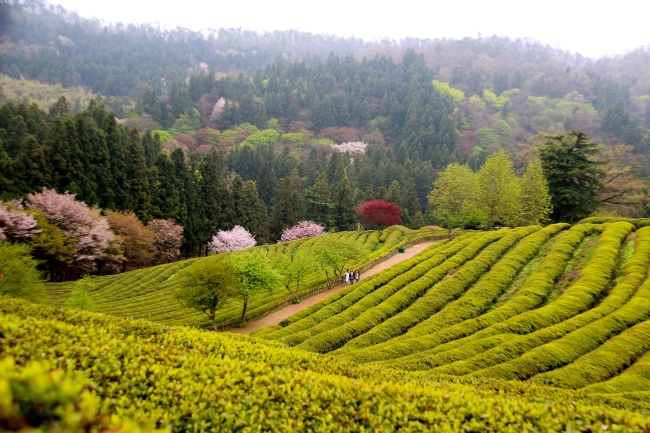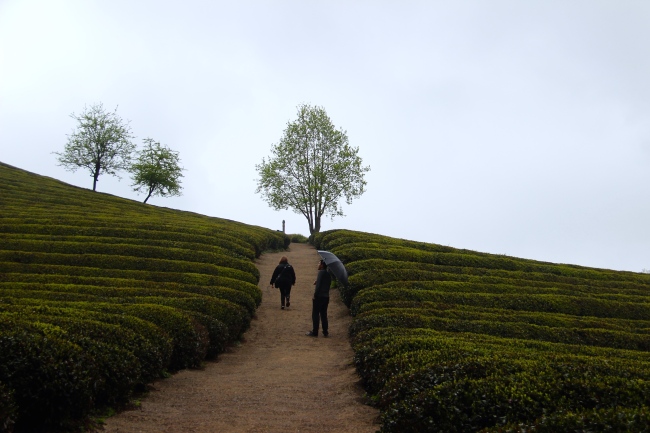[Weekender] Tea fields in Boseong beckon with natural green splendors
By Rumy DooPublished : April 22, 2016 - 17:50
BOSEONG, South Jeolla Province -- While nearby tropical nations like the Philippines and Indonesia have their hanging rice terraces in Banaue and Tegalalang that serve as major tourist attractions, Korea also has its own natural green splendors for tourism.
Located at the southern tip of the peninsula is the Daehan Dawon Tourist Tea Plantation -- more often known as Boseong Green Tea Plantation -- in Boseong, South Jeolla Province.
The lusciously vibrant green tea fields of Boseong is the nation’s best-known green tea plantation and annually attracts roughly 1 million visitors looking to experience green tea in a scenic environment. Considered the birthplace of the commercial tea industry in Korea, the plantation is the largest producer of tea in the nation, accounting for approximately 40 percent of the country’s total green tea production.
Located at the southern tip of the peninsula is the Daehan Dawon Tourist Tea Plantation -- more often known as Boseong Green Tea Plantation -- in Boseong, South Jeolla Province.
The lusciously vibrant green tea fields of Boseong is the nation’s best-known green tea plantation and annually attracts roughly 1 million visitors looking to experience green tea in a scenic environment. Considered the birthplace of the commercial tea industry in Korea, the plantation is the largest producer of tea in the nation, accounting for approximately 40 percent of the country’s total green tea production.

“This is not my first visit here, I actually can’t remember how many times I have been here because I always stop by when I’m down here visiting relatives,” said Lee Jung-hwa, who was visiting the tea field with her family.
“It’s just beautiful here, what else can I say? I love coming here and taking pictures with my kids,” she added. “It’s so green and the landscape is amazing ... the area makes for such a pretty backdrop for pictures, and I think that’s why most people loving coming here.”
Nestled in the center of a heavily forested area, the plantation features row upon row of green tea plants. A walk through Boseong’s 560-hectare green tea labyrinth is an unforgettable experience, and a photographer’s dream. It’s highly recommended to visit the fields during May and June, when the tea leaves are at their greenest.
To say green tea is fundamental in everyday Boseong life is an understatement. The citizens of Boseong have managed to infuse green tea into nearly every aspect of their lives. Besides the county’s bountiful production of green tea drinks, cakes, cookies and ice cream, it even offers a unique twist to popular Korean dishes such as nokcha samgyeopsal, which is grilled pork belly from pigs that are fed green tea leaves, and nokcha kimchi jjigae, which is green tea kimchi stew.
“When Koreans think green tea, they immediately think Boseong,” said a Boseong native and green tea vender at Daehan Tea Plantation.
“This is Boseong, so green tea is everywhere. But you don’t have to love green tea to be able to love and appreciate visiting the city and the plantation. Just look around, it is one of the most beautiful locations in the country, which is why it attracts so many photographers and filmmakers who come here to shoot scenes for TV dramas.”

The vast Daehan plantation was established in 1939 during Japan’s colonial rule over Korea. After Korea’s liberation in 1945 and the subsequent departure of the Japanese, the plantation was left abandoned until a Korean entrepreneur purchased the neglected fields and created Daehan Tea Plantation.
Boseong was selected as an ideal place to produce green tea because of the area’s deep and fertile soil as well as its location near Yulpo Beach. The tea has a distinct taste because the plantation is located 100 meters above sea level. The cool ocean breeze and minimal exposure to direct sunlight allows the tea leaves to develop a full, robust flavor.
The county of Boseong has been celebrating its agricultural staple for the past four decades with its annual Boseong Green Tea Festival. This year’s tea festivities will be held from May 4 to 8.
Some of the most popular events held during the Boseong Green Tea Festival include going out into the fields and picking tea leaves, then learning how to roast them. Participants also have the opportunity to sample green-tea-infused snacks and drinks.
The annual festival also features music performances and various hands-on programs such as tea-based food making, green tea sampling as well as green tea beauty and health experiences.
How to get there:
Getting to Boseong from Seoul is a bit of a time-consuming trip but is well worth the effort. Most visitors take a bus or train to Gwangju and from there, transfer to a bus heading to Boseong Bus Terminal. Then from Boseong’s terminal, transfer to a city bus that departs directly from the terminal to reach the tea plantation.
A second option is to take the direct bus service to Boseong from Seoul’s Express Bus Terminal in Seoul, however, this service only runs twice a day –- departing from Seoul at 8:10 a.m. and 3 p.m. Either way, the total travel time will be roughly five hours, sometimes longer depending on traffic conditions.
By Julie Jackson (juliejackson@heraldcorp.com)








![[KH Explains] How should Korea adjust its trade defenses against Chinese EVs?](http://res.heraldm.com/phpwas/restmb_idxmake.php?idx=644&simg=/content/image/2024/04/15/20240415050562_0.jpg&u=20240415144419)










![[Today’s K-pop] Stray Kids to return soon: report](http://res.heraldm.com/phpwas/restmb_idxmake.php?idx=642&simg=/content/image/2024/04/16/20240416050713_0.jpg&u=)